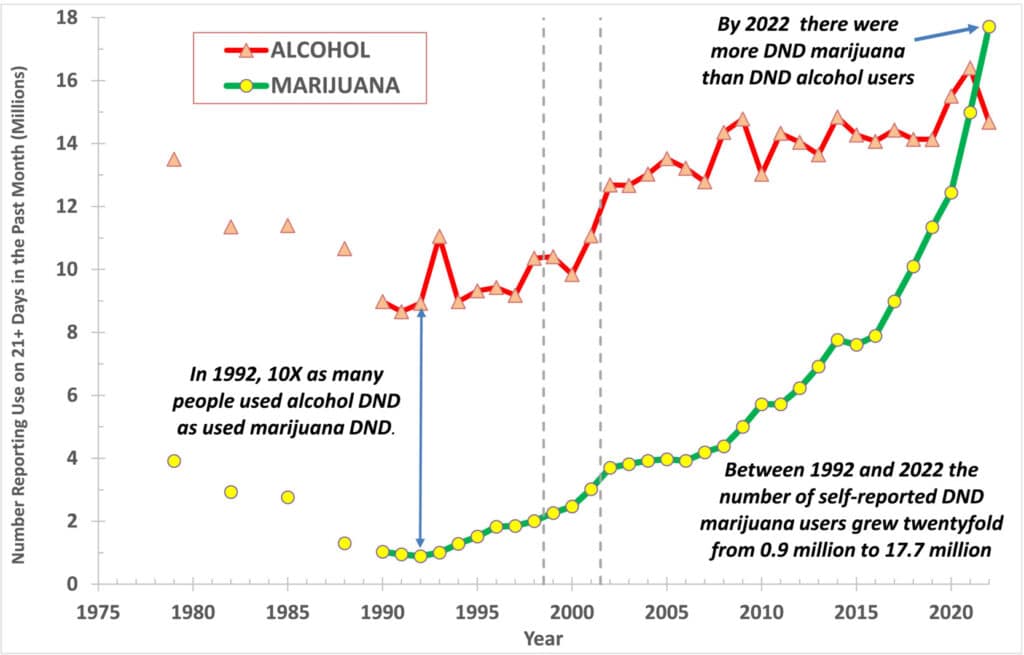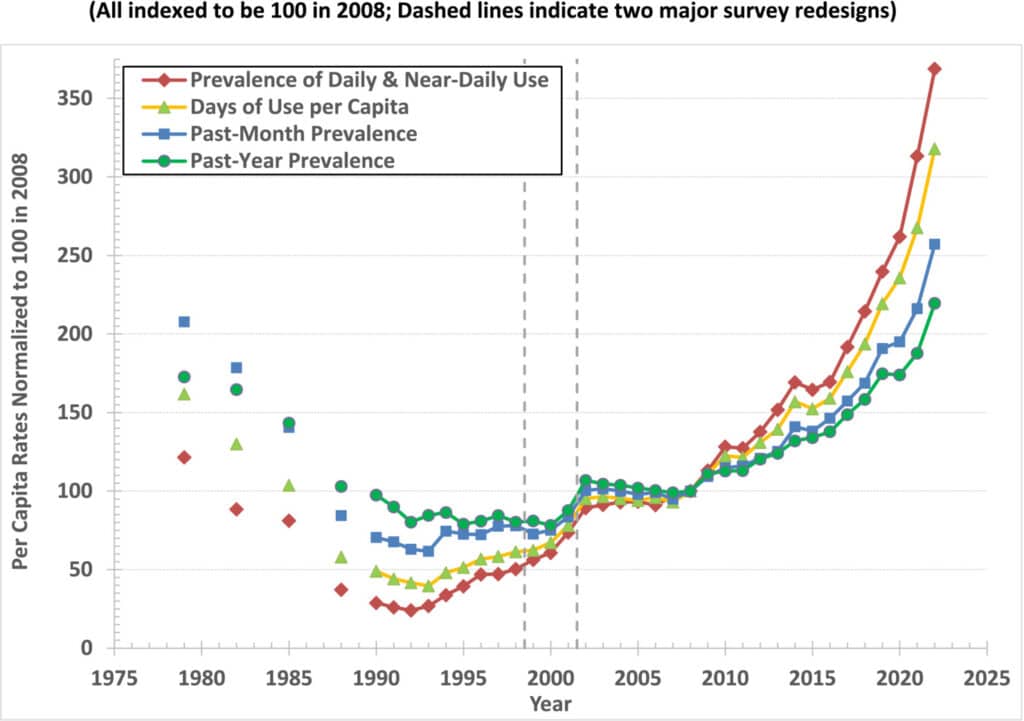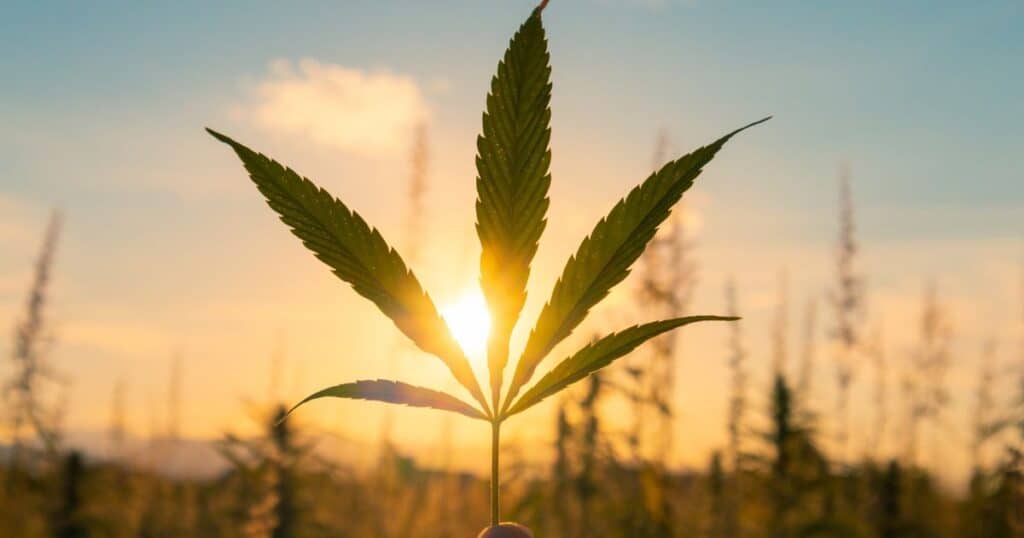United States – In a development that’s unsurprising to those in the cannabis industry, a recent study reveals that daily cannabis use has now surpassed daily alcohol use in the United States. This acknowledgment, backed by concrete data, highlights a significant shift in substance consumption trends and reflects changing public attitudes and policies toward cannabis. For cannabis users and people in the industry, this proves the growing acceptance and normalization of marijuana in American society.
Key Findings of Study
The research, published in the journal Addiction, is based on data from the National Survey on Drug Use and Health (NSDUH). It analyzes 27 different surveys and responses, totaling 1,641,041 participants spanning over four decades, providing a comprehensive overview of substance use trends in the U.S.
Notably, the study highlights the following key findings:
- Daily Marijuana Use Outpaces Daily Drinking: In 2022, an estimated 17.7 million people reported using marijuana daily or near-daily, compared to 14.7 million people who reported drinking alcohol with the same frequency. This is the first time in history that high-frequency marijuana use has overtaken high-frequency drinking.
- A 15-Fold Increase in Marijuana Use: From 1992 to 2022, the per capita rate of reporting daily or near-daily marijuana use increased 15-fold. This dramatic rise reflects both changing societal attitudes and the growing legalization of cannabis we’ve seen over the years.
- Widespread Acceptance and Legalization: As of 2022, 38 states and the District of Columbia have legalized medical marijuana, while 24 states have approved recreational use. These policy changes have undoubtedly influenced consumption patterns.


The Rise of Cannabis
The growing daily use of cannabis isn’t just a statistical quirk; it shows a broader cultural change. Over recent decades, marijuana has moved from being stigmatized to becoming a mainstream, legally accepted product. Several factors have driven this shift.
Policy Changes
The gradual legalization of medical and recreational marijuana across numerous states has made cannabis more accessible and acceptable. Recreational use of cannabis is allowed in 24 states and the District of Columbia, while 38 states have legalized its medicinal use.
Additionally, voters in Florida are considering constitutional amendments to legalize recreational cannabis this November. If passed, this would mean that half of the United States would have a recreational cannabis program.
Public Perception
As societal attitudes towards marijuana have softened, more people feel comfortable admitting their cannabis use. This normalization is likely reflected in the self-reported data from the NSDUH.
Jonathan Caulkins, a cannabis policy researcher at Carnegie Mellon University and the study’s author, notes that “a good 40% of current cannabis users are using it daily or near daily, a pattern that is more associated with tobacco use than typical alcohol use.”
This shift suggests that marijuana is becoming a regular part of many Americans’ lives, similar to how tobacco was once consumed.
Cannabis vs. Alcohol
One of the most striking aspects of this study is the changing dynamics between marijuana and alcohol use. While alcohol remains more widely used overall, the frequency of high-intensity drinking has decreased, whereas daily cannabis use has surged.
Several factors could explain why more Americans are turning to marijuana over alcohol on a daily basis:
- Health Perceptions: Many users perceive cannabis as a healthier alternative to alcohol. While both substances have their risks, the absence of hangovers and the lower associated risk of physical harm may make marijuana more appealing for daily use.
- Variety of Consumption Methods: The legalization of cannabis has led to a proliferation of products, from edibles and tinctures to vapes and topicals. This variety allows users to choose consumption methods that suit their lifestyles and preferences.
- Cost and Accessibility: As marijuana becomes legalized in more states, its price has dropped, and its availability has increased. This makes it easier for users to incorporate cannabis into their daily routines.
Not only has daily cannabis use become more prevalent, but states are also seeing a significant shift in tax revenue, favoring cannabis over alcohol. 2023 data shows that in several states, cannabis tax revenue has surpassed alcohol tax revenue.
Notably, states such as Arizona, Colorado, Maine, Massachusetts, Michigan, Montana, Nevada, New Mexico, and Oregon have all reported higher tax earnings from marijuana than from alcohol. This trend, outlined by the Tax Foundation, underscores changing consumer preferences and the increasing normalization of cannabis in American society.
Regulatory Landscape
While marijuana is gaining acceptance at the state level, it remains illegal at the federal level. However, there are signs of change on the horizon. In a significant move, the U.S. federal government has recently taken steps to reclassify cannabis from a Schedule I controlled substance (on par with heroin) to a Schedule III substance.
This reclassification could significantly impact the cannabis industry in the United States. One notable consequence would be that the government could now conduct studies on its benefits, potentially unlocking a wealth of valuable information. President Biden has also acknowledged the need for reform, stating, “Far too many lives have been upended because of our failed approach to marijuana.”

The recent study showing that daily marijuana use has surpassed daily alcohol use in the U.S. marks a significant milestone in the evolving landscape of substance consumption. For cannabis enthusiasts, this is a testament to the growing acceptance and normalization of marijuana. As the industry continues to grow and innovate, the future of cannabis looks promising.

















